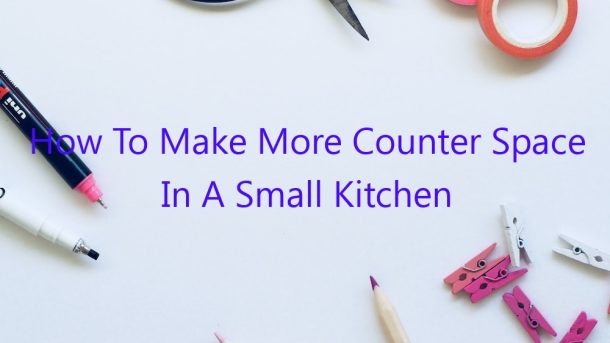Counter space is a valuable commodity in any kitchen, but it can be especially scarce in smaller kitchens. If you’re looking for ways to make more counter space in a small kitchen, here are a few ideas to get you started.
One easy way to create more counter space is to install a kitchen island. Kitchen islands provide a lot of extra storage and work space, and they can be customized to fit your specific needs.
If you’re not able to install a kitchen island, you can try using a bar cart or a rolling cart. Bar carts are perfect for small kitchens, and they can be used to store kitchen supplies, as well as to hold appliances like a toaster or a coffee maker. Rolling carts are also a great option, and they can be used to store food or dishes.
Another way to create more counter space in a small kitchen is to use a fold-out table. A fold-out table can be used as an extra work surface, or it can be used to store dishes or food.
If you’re short on counter space, try using wall-mounted shelves. Wall-mounted shelves can be used to store pots and pans, as well as cookbooks and other kitchen supplies.
Finally, don’t forget about the power of organization. Organization can help you make the most of the counter space you have, and it can also help to make your kitchen more functional and efficient.
Contents [hide]
How do I maximize my kitchen cabinet space?
There are many ways to maximize kitchen cabinet space. Below are some tips to help you get started.
One way to maximize kitchen cabinet space is to use the space above the cabinets. Install a shelf or cabinet topper to create more storage space.
Another way to maximize cabinet space is to use the inside of the cabinet doors. Install a cabinet organizer to create more storage space.
You can also use the back of the cabinet doors to store items. Install a cabinet organizer or attach a magnetic strip to the back of the cabinet door to store knives, spoons, or other small items.
If you have a lot of pots and pans, you can store them in the cabinet by using a pot rack.
You can also store food items in the cabinet by using a cabinet organizer or by using clear storage containers.
By using these tips, you can maximize your kitchen cabinet space and get more organized.
What is a good amount of counter space in kitchen?
A good amount of counter space is important in a kitchen. It allows you to have a work surface to prepare food and also to store food. The amount of counter space you need depends on the size of your kitchen and how you use it.
If you cook a lot, you may need more counter space. If you only cook occasionally, you may be able to get by with less counter space. The best way to figure out how much counter space you need is to take a look at your kitchen and think about what you use the counter for.
If you like to cook and bake, you’ll need more counter space than someone who just prepares basic meals. If you like to prepare meals with a lot of ingredients, you’ll need even more counter space. If you like to cook with hot pans, you’ll need a surface that is heat-resistant.
If you like to chop a lot of vegetables, you’ll need a cutting board. If you like to do a lot of baking, you’ll need space to roll out dough. If you like to have a lot of gadgets and appliances out on the counter, you’ll need more counter space.
Think about the things you like to do in the kitchen and how much space you need to do them. Then, measure your kitchen and see how much counter space you have. If you don’t have enough counter space, you may want to consider adding a counter or expanding your kitchen.
Where should pots and pans be placed in kitchen?
Where should pots and pans be placed in kitchen?
Most people place their pots and pans in a cabinet above the stove. However, some people like to place them on a shelf above the stove. Others like to place them in a pot rack that is hanging from the ceiling.
Where should plates and cups go in a kitchen?
Where to place dishes and cups in a kitchen can be a little confusing, since there are a few different schools of thought on the matter. Ultimately, it’s up to the individual to decide what works best for them and their kitchen. However, here are a few general guidelines to help get you started.
One option is to place plates and cups on a shelf near the sink. This is a convenient option if you do a lot of dishwashing, as you can quickly rinse and place the dishes back on the shelf. It also keeps the dishes within easy reach should you need them during cooking.
Another option is to place plates and cups on a shelf or in a cabinet near the stove. This is a good option if you cook often, as you can easily grab what you need without having to walk across the room. It’s also handy for storing dishes that you use less often.
Finally, some people choose to place plates and cups in a cabinet or drawer near the table. This is a good option if you often have guests over, as it makes it easy to serve food and drinks. It also keeps the dishes out of the way when they’re not in use.
No matter where you choose to place your dishes and cups, be sure to make sure they’re easy to access. You don’t want to have to fumble around to find what you need when you’re in the middle of cooking or hosting a party.
What is considered a small kitchen?
A small kitchen is a kitchen that is designed for a limited amount of space. Small kitchens can be found in all kinds of homes, from apartments to small houses. If you are remodeling or designing a kitchen, it is important to know what is considered a small kitchen so that you can make the most of the space you have.
There are a few things to consider when designing a small kitchen. The first is the size of the kitchen itself. A small kitchen should be no more than 150 square feet. If your kitchen is larger than that, you may want to consider remodeling to make better use of the space.
The layout of the kitchen is also important in a small kitchen. You will want to choose cabinets and appliances that are compact and space-saving. You may also want to consider using a work island or peninsula to help you make the most of the space.
Finally, it is important to think about the storage in a small kitchen. You will want to choose cabinets and shelves that can accommodate your needs without taking up too much space. You may also want to consider using storage solutions like baskets and bins to help you keep your kitchen organized.
A small kitchen can be a great option for those who want to save on space. By using the tips above, you can create a functional and stylish kitchen that works well in a small space.
How much space is needed between refrigerator and dishwasher?
How much space is needed between a refrigerator and dishwasher?
When it comes to appliances, there is definitely a need for some space in between. But how much space is needed specifically between a refrigerator and dishwasher?
The answer to that question is: about 24 inches. If there is less than that, then there is the potential for the cold air from the fridge to affect the performance of the dishwasher, and vice versa.
Having that extra space is also important for cleaning and maintenance purposes. For example, if something goes wrong with one of the appliances, it will be easier to troubleshoot and fix if they are not too close together.
In general, it is a good idea to leave some breathing room between all of your appliances, not just the fridge and dishwasher. That way, you can be sure that each one is functioning optimally and that they are all getting the proper airflow.
Where should heavy pots and pans be stored Why?
Heavy pots and pans can be a pain to move around in the kitchen, so it’s important to store them in a place where they’re easy to access. Here are a few tips on where to store your heavy pots and pans.
If you have a lot of counter space, you can store your pots and pans on the counter. This will make them easy to access when you’re cooking.
If you don’t have a lot of counter space, you can store your pots and pans in a cupboard or on a shelf. Just be sure to leave enough room to open the cupboard or the door of the shelf.
If you have a lot of cabinets, you can store your pots and pans in a cabinet near the stove. This will make them easy to access when you’re cooking.
If you don’t have a lot of cabinets, you can store your pots and pans in a cabinet near the sink. This will make it easy to wash them when you’re done cooking.
No matter where you store your pots and pans, be sure to put them away when you’re finished cooking. This will keep your kitchen organized and make it easier to find what you’re looking for.




